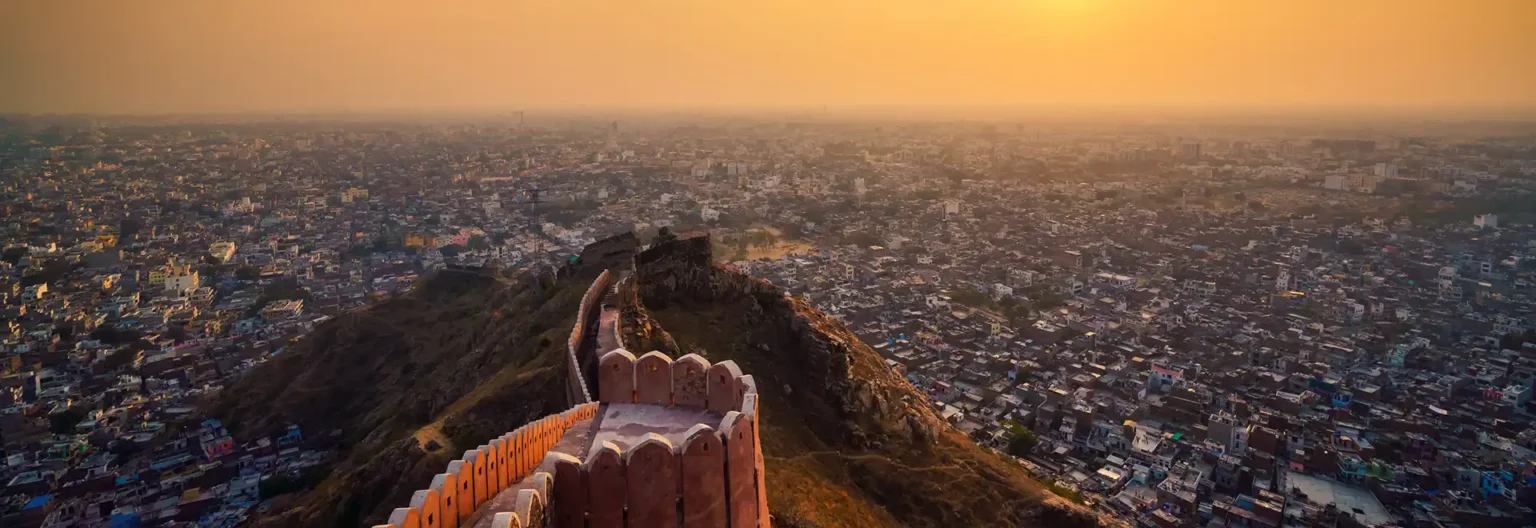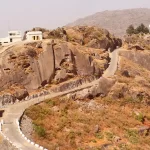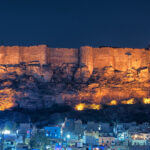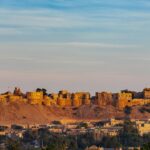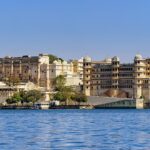Jaipur: Gateway to Rajasthan
Jaipur is the capital of Rajasthan and famous for its rich history, culture, and stunning architecture. Also known as the “Pink City” because of its red terracotta-colored buildings, Jaipur was founded by Maharaja Jai Singh II in 1727. The city was among the first planned cities of India, designed with a focus on geometry and urban planning. It beautifully blends Rajput and Mughal architectural styles.
Jaipur is known for its beautiful forts and palaces, such as Amber Fort, Hawa Mahal, and the City Palace. These structures are an epitome of the royal grandeur of Rajasthan with intricate carvings, frescoes, and grand courtyards. Jaipur also houses some of the most happening markets in the city, including Johari Bazaar and Bapu Bazaar, where tourists can shop for traditional crafts, textiles, and jewelry.
Jaipur’s culinary tastes reflect its cultural richness, as epitomized by dishes like Dal Baati Churma, Laal Maas, and Ghevar-these are true flavors from Rajasthan. The city abounds in cultural events such as the Jaipur Literature Festival and Teej Festival which add to the vibrant atmosphere, making it a place that no travel enthusiast would want to miss going to.
Best Time to visit Jaipur
The best time to visit Jaipur depends on the kind of experience you are seeking:
- Winter (October to March): This is the best time to visit Jaipur. The weather is cool and pleasant, ideal for sightseeing and outdoor activities. Day temperatures are between 20°C and 30°C, and night temperatures can drop to around 5°C to 15°C. Annual Jaipur Literature Festival and other cultural events occur during this season.
- Summer (April to June): The summers of Jaipur can be hot, with the temperatures sometimes crossing 40°C. It is not really the best time for outdoors. Still, you can visit here to enjoy the off-season because of low hotel rates and not too many people around.
- Monsoon (July to September): During the time of the monsoon season, heat will be partly alleviated; however humidity increases; the rain itself might limit one’s plan to move around and even with lesser people around, rainy delays should not be risked.
Popular Jaipur Sites
Jaipur is home to some of the most iconic landmarks of Rajasthan. From palaces to temples, the city is rich in culture and history. Some of the top attractions in Jaipur include:
1.Amber Fort:
Situated atop a hill, Amber Fort is a wonder in architecture. This is one of the major tourist attractions in Jaipur due to its delicate carvings, large courtyards, and stunning views of the surrounding landscape. Tourists can go through this fort on an elephant’s back or even by jeep.
2.City Palace:
This is a beautiful complex of Mughal and Rajasthani architecture that houses museums, courtyards, and courtyards with art galleries. The palace still functions as the residence of the royal family.
3.Hawa Mahal:
This is popularly known as the “Palace of Winds,” with 953 small windows (jharokhas) designed to let the royal ladies observe life on the streets without being seen.
4.Jantar Mantar:
Now a UNESCO World Heritage Site, Jantar Mantar was an 18th-century astronomical observatory. This site contains several large instruments used in measuring astronomical parameters, and it is the largest instrument of its kind in India.
5.Jaipur Forts and Palaces:
Jaipur has other great forts and palaces, such as Nahargarh Fort, Jaigarh Fort, and the Albert Hall Museum, with their royal architecture and stunning views of the city.
6.Jal Mahal:
Located in the center of Man Sagar Lake, this beautiful palace appears to float on the water. One cannot go inside, but the beauty of this place, especially at sunrise or sunset, is breathtaking.
7.Bazaars of Jaipur:
Among the most sought-after markets in Jaipur are Johari Bazaar and Bapu Bazaar. Filled with colorful textiles, jewelry, handicrafts, and souvenirs, these bazaars bring out the artistic traditions of Rajasthan.
Adventure Activities in Jaipur
Jaipur offers a few adventurous activities for those who want to explore beyond the cultural sites:
- Hot Air Balloon Ride: You can also take a hot air balloon ride over Jaipur, which is a very different and breathtaking experience. You will get the bird’s eye view of the forts, palaces, and the city itself. The ride typically lasts for around an hour and gives the serene and magnificent landscape perspective.
- Camel Safari: There is a possibility of camel safari in the outskirts of Jaipur. It will take you to the nearby desert where you can enjoy the rustic beauty of the Rajasthan desert while learning about traditional desert life.
- Trekking: Trekking in the hills around Jaipur, especially in the Amber Fort area, is pretty good. The trek to the fort offers a great combination of nature and history.
- Jeep Safari: Jeep safaris in the outskirts of Jaipur take you through villages and less-known lesser forts amidst a tough landscape.
Cultural Significance
Jaipur is a city that has deep historical and cultural roots since it was the capital of the Rajput kingdom of Amber for many years before it became the capital of the princely state of Jaipur. The city was founded in 1727 by Maharaja Jai Singh II, and it reflects the Rajput ethos through its monuments, artwork, and way of life.
The city of Jaipur boasts the Jaipur Literature Festival and Teej Festival to name a few, which are representative of the very strong cultural tradition of this town. Music, dance, literature, and art form are celebrated in these festivals. Folk music and folk dance of Rajasthan is equally significant in the cultural scenario, and the events are conducted at multiple venues in the town.
Language and Communication
The native language in Jaipur is Hindi, although the local residents commonly speak Rajasthani. In the touristic areas, hotels, and restaurants, the people often speak and understand English. Knowing simple Hindi can aid one to communicate with locals, especially in more rural or conservative regions.
Clothing Essentials and Weather Preparedness
Jaipur’s clothing will depend on the season:
•Summer: Light cottons are a must for the scorching heat. Pack sunscreen, sunglasses, and a hat for protection.
•Winter: In winter, the evenings and nights can be quite cool in Jaipur, so one must carry light woolens or jacket with comfortable clothes for sightseeing during the day.
•Monsoon: If visiting during the rainy season, pack an umbrella or raincoat, as sudden downpours can occur. Waterproof shoes are also advisable.
Travel Tips for Jaipur
•Hydrate: Jaipur can get pretty hot, especially during summer, so drink lots of water while sightseeing.
•Book Attractions in Advance: Many of Jaipur’s famous attractions such as Amber Fort and City Palace have long lines, especially when it’s peak season. Getting tickets booked in advance could save time.
•Dress Conservatively and Respect the Local Customs: Rajasthan is a conservative society, and this is especially so in rural areas. One must dress conservatively and respectfully when visiting the temples or interacting with the people.
•Bargain at Bazaars: While going to shop in markets of Jaipur, you are bound to bargain. This is the way, and you will discover that you are going to get the best value by negotiating with shopkeepers.
Transportation and Connectivity:
Jaipur has good connectivity with rest parts of India through roads, rail, and air.
• By Air: The international airport of Jaipur provides both domestic as well as international flight services. The city center is about 13 km from it.
•By Train: It is a major railway station with well connectivity to the other cities and towns of India. The best way of traveling to Jaipur is from any neighboring city like Delhi, Agra, and Mumbai.
•By Road:Well connected by national highways through regular buses and taxis on long routes.
•Intra-city Travel: To travel within Jaipur, a taxi, auto-rickshaws, or the metro services in the city can be used.
Weather in Jaipur
Jaipur has a dry climate with extreme summers, cool winters, and moderate monsoons. Summer is hot, and this season the temperature may reach as high as 40°C (104°F). The winters are much pleasanter, and the temperature goes from 8°C to 24°C (46°F to 75°F), which is the best time to visit the place.
Places to Visit
Some interesting places are nearby Jaipur that you can visit.
1.Ajmer(130 km): It is renowned for the sacred Sufi dargah of Ajmer Sharif.
2.Pushkar (145 km): It is famous for the sacred lake of Pushkar and the Brahma Temple.
3.Amber (11 km): Historic Amber Fort is located only 11 km from Jaipur.
4.Bhangarh Fort (83 km): It is one of the major tourist attractions, famous as the haunted place.
5.Nahargarh Fort (6 km): A hilltop fort offering some excellent views of Jaipur city.
6.Sambhar Lake (70 km):India’s largest saltwater lake and an ideal picnic destination for the nature-loving people.
Conclusion
Jaipur is the royal heritage city, and its architecture, culture, and traditions are worth witnessing for a traveler who wishes to get into the real essence of Rajasthan. Be it its grand forts, its lively markets, or the local Rajasthani food, there’s something in Jaipur for every kind of traveler. It is one of those cities that seamlessly combine the old and new, giving a memory that would last forever.

